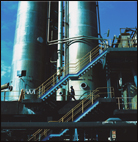Casting is a manufacturing process by which a liquid material is usually poured into a mold, which contains a hollow cavity of the desired shape, and then allowed to solidify. The solidified part is also known as a casting, which is ejected or broken out of the mold to complete the process. Casting materials are usually metals or various cold setting materials that cure after mixing two or more components together; examples are epoxy, concrete, plaster and clay. Casting is most often used for making complex shapes that would be otherwise difficult or uneconomical to make by other methods.
The most important and integral part of metal casting is the mold. The mold is essentially what the product is going to be. These molds are manufactured in a foundry. Manufacturers take their dimensions, sketches and ideas for the mold to the foundry where the molds are produced. These molds then get sent off to the casters. Casters put the completed mold into a back up frame that contains cooling apparatus. The melting down of the metal happens in a very particular place in the foundry. When the mold is done and is ready to be cast, casters move the liquefied metal over large machines and equipment above the mold, this equipment helps the liquefied metal flow down into the cast. This equipment also monitors the rate at which the liquid metal flows into the cast. The cooling equipment then cools the metal down allowing the metal to harden and become a solid state. The castings are now removed and the product is now ready to be cleaned.
'Non-expendable' Mold Casting- This technique is inclusive of at least 4 distinct methods: continuous, centrifugal, die, and permanent casting.
Continuous Casting- Continuous casting can be defined as a refined process of casting for high volume, continuous production of metal sections with constant cross section. The pouring of molten metal into a water cooled, open ended copper mold take place. This allows a layer of solid metal to be formed above the still liquid center. Continuous casting is widely accepted due to its cost effectiveness. The metals continuously xast are aluminum copper and steel.
Centifugal casting: Centrifugal casting is independent of both-pressure and gravity. This is because its own ‘force feed’ is created by the way of using a ‘temporary sand mold’ in ‘spinning chamber’ at 900 N. Lead time is variant with respect to application. True- and semi-centrifugal processing allow 30 to 50 pieces/hr.The batch processing has an upper limit of around 9000 Kg (practically). This method used to be applied for ‘Casting of Railway Wheels’. It was developed by the company called ‘Krupp’. It had a German origin. Jewelry is normally cast by this method.
Die-casting: Die casting can be defined as a process of ‘forcing molten metal’ into cavities of mold under high pressure. These castings comprise of non-ferrous metals, especially-alloys of aluminum, copper, and zinc. It is even possible to make die castings of metal. The method of die casting is used where finer parts are needed.
Permanent Mold Casting:This casting is made up of non-ferrous metals. It requires some time to set up (some weeks), after which the production rate of about 5 to 50 pieces/hour-mold is achieved. The coating of ‘acetylene soot’ is applied to steel cavities. This helps in removing the work piece easily and promoting longer life (of tools).Permanent molds possess a limited life span. For worn molds, replacement ore finishing is required.
Expendable mold casting: ‘Expendable Mold casting’ can be referred to as a standardclassification inclusive of the following:
Sand casting: It is amongst the simplest and most popular casting types used sinceages. It involves very small size operations. The bonding of sand takes placeby use of clays (as in ‘green sand’) or ‘polymerized oils’, or ‘chemicalbinders’. Recycling is easily possible.
Plaster casting (for metals): There is no difference between plaster casting and sand casting, except the fact that plaster is used in place of sand. Similarly , there are also plastic and concrete castings.
, there are also plastic and concrete castings.

At Thermometrics, our guiding objectives are Customer Satisfaction and Continuous Improvement. We accomplish this through monitoring our systems, measuring our performance and employee development. Our goal is to continually work at being the most successful company in the world, in delivering the highest quality of products, technology, competitive pricing, continuous customer service and satisfaction.